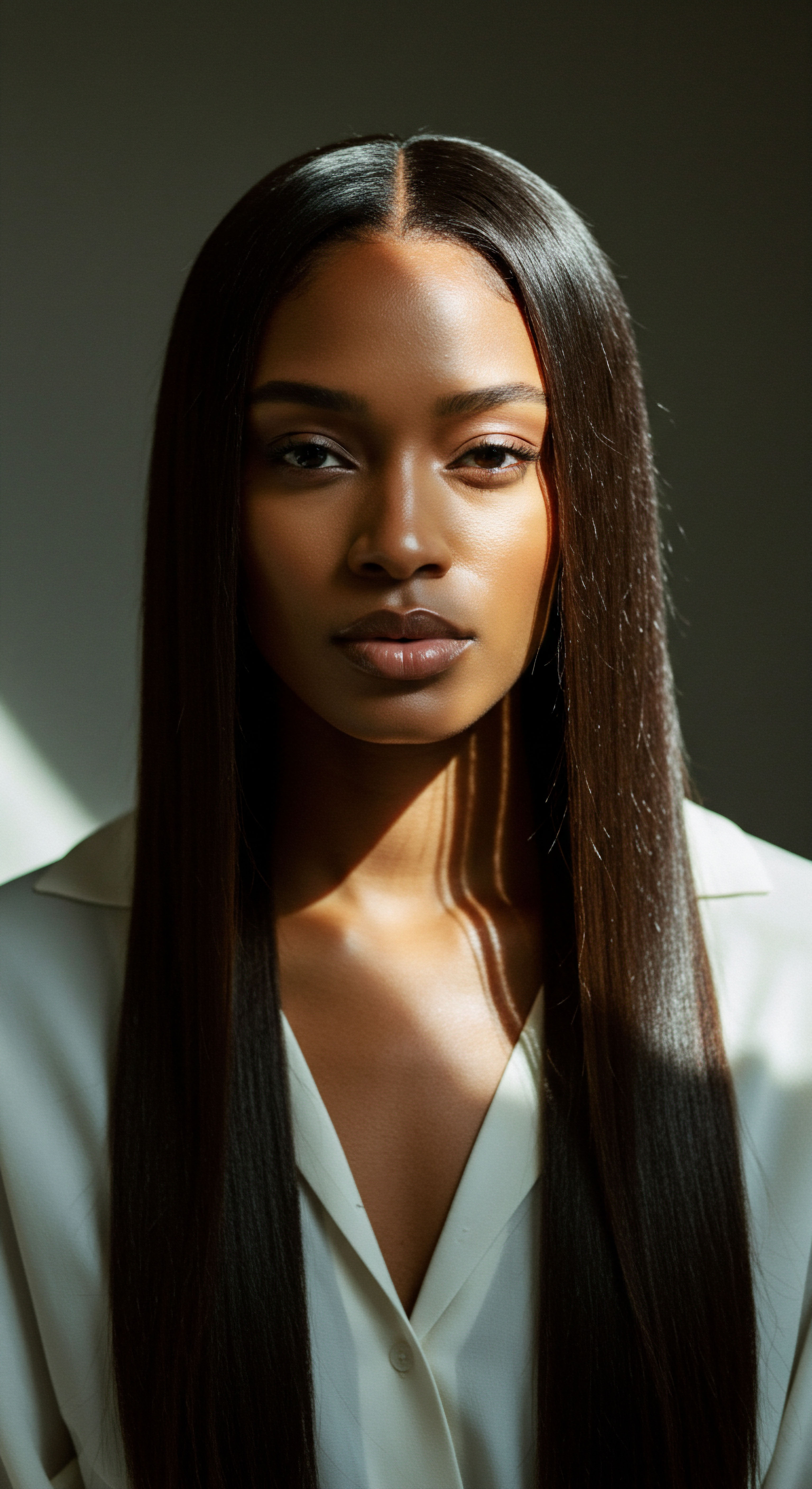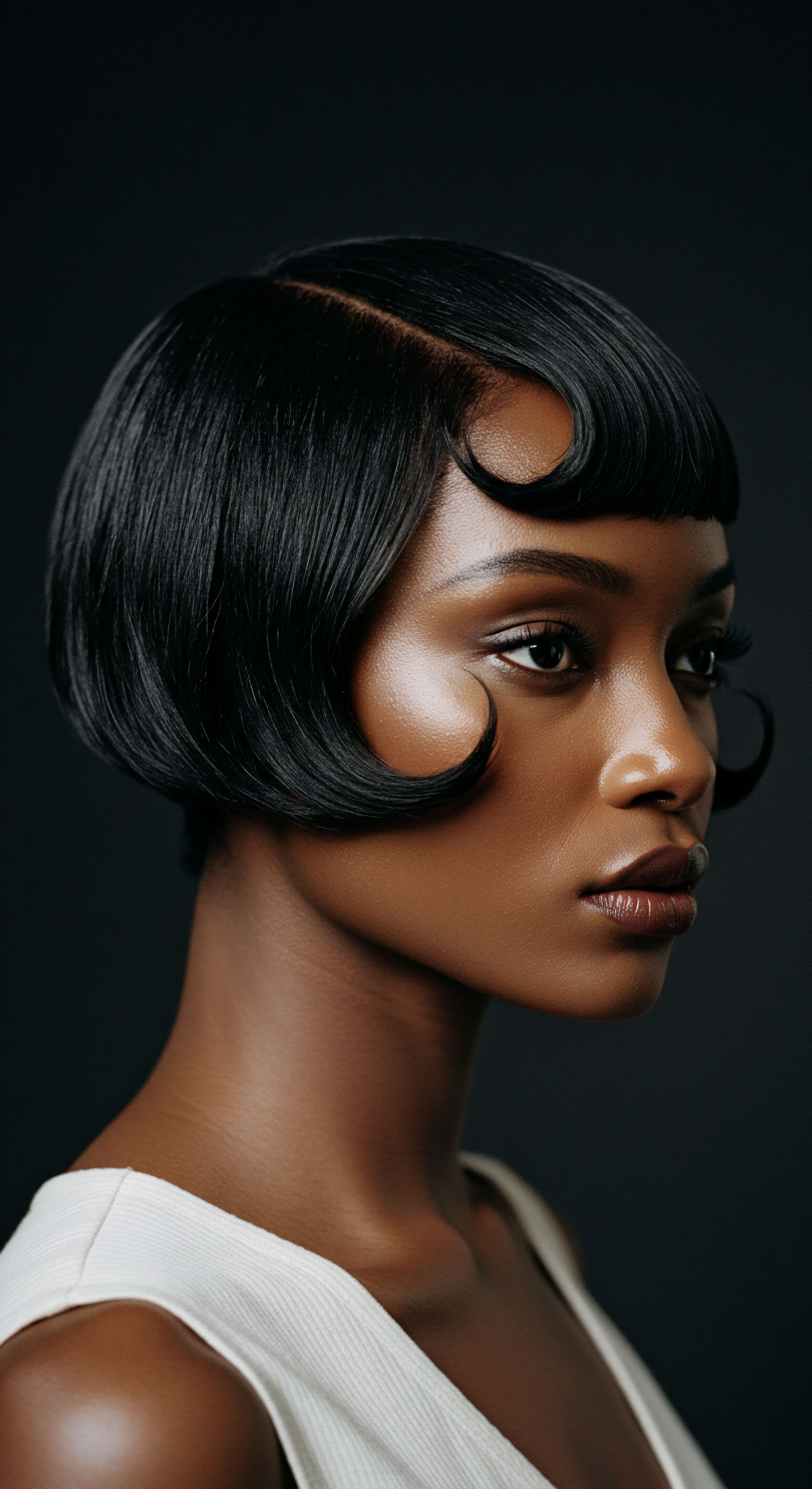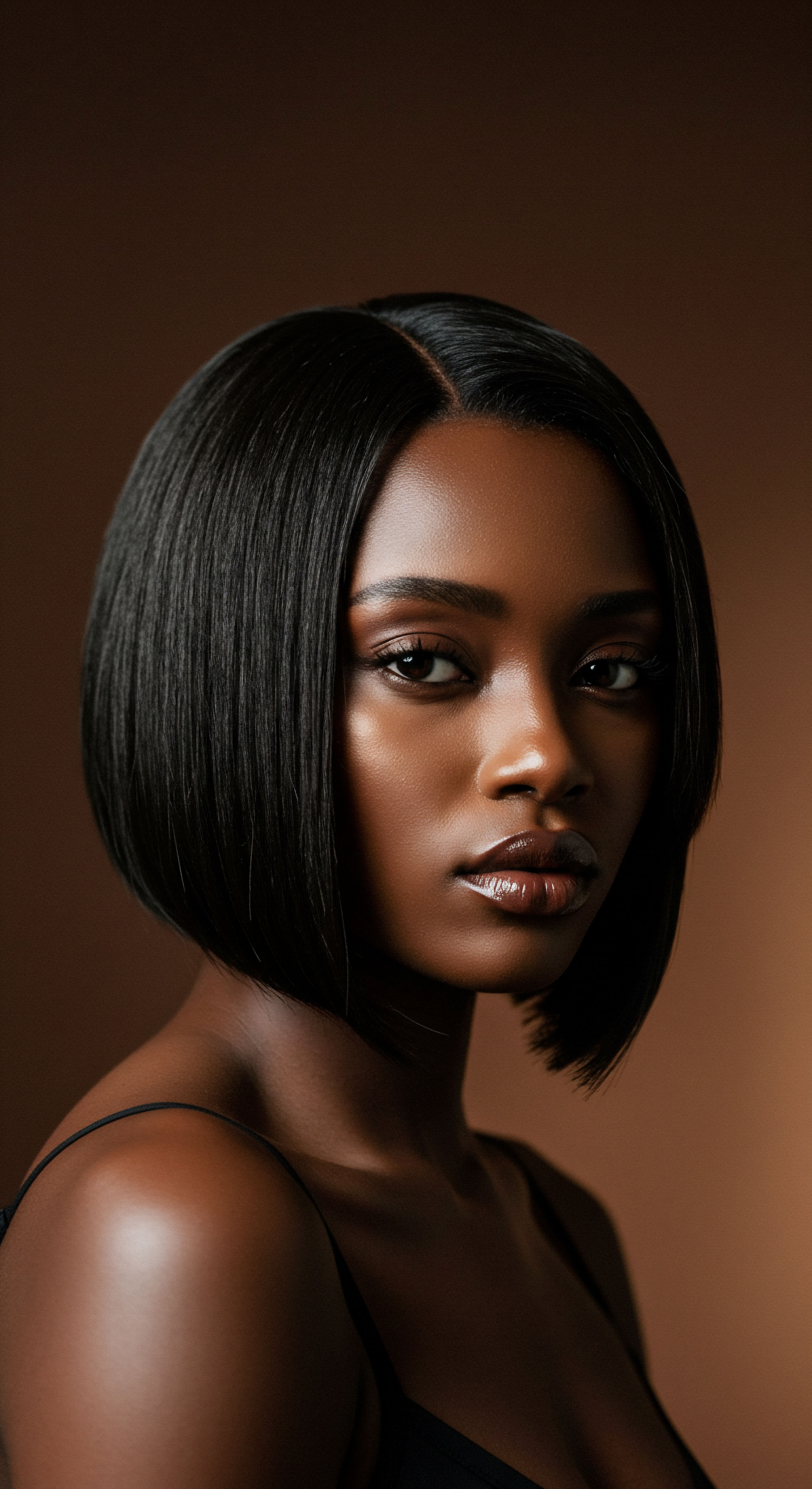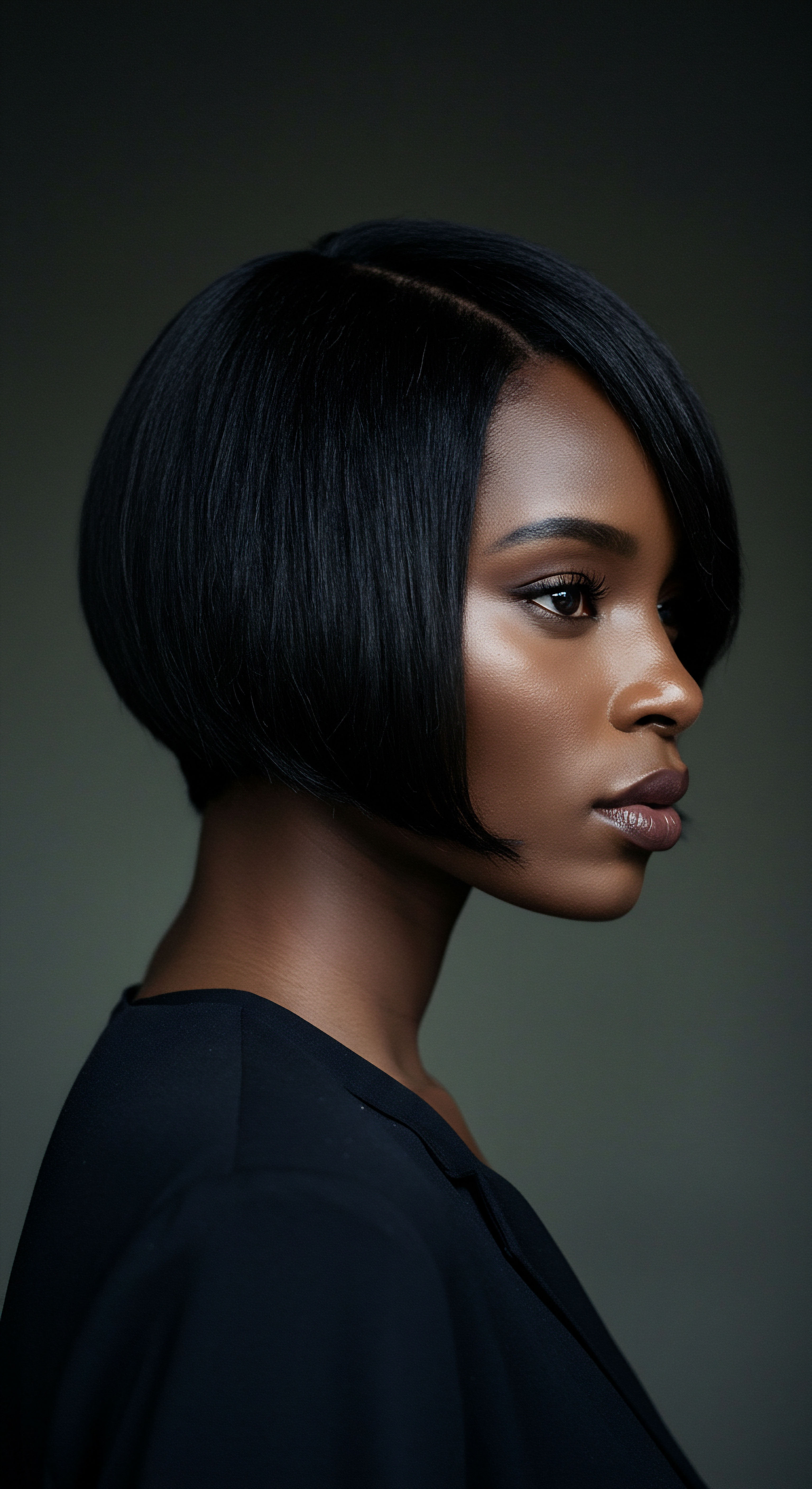
Roots
Consider the silent, often unseen forces that shape the very nature of our textured strands. From the moment water graces our hair, a subtle, intricate exchange begins, one that can either bestow a soft caress or leave behind a stubborn, unyielding presence. This interaction, particularly with water laden with certain geological legacies, holds significant sway over the vibrancy and vitality of curls, coils, and waves.
Understanding the fundamental composition of both our hair and the water it encounters provides a quiet strength, a knowing glance into the true story of our hair’s daily existence. It is in these foundational truths that we begin to discern the whispers of damage, the subtle shifts in texture that hint at mineral visitors.

The Unique Architecture of Textured Hair
Textured hair, with its remarkable diversity of curl patterns, possesses an inherent structural distinctiveness. Unlike straight hair, which often presents a smooth, uniform surface, each strand of textured hair coils or bends, creating natural points of elevation and depression. This unique morphology means that the cuticle, the outermost protective layer of the hair shaft, is often lifted or unevenly laid along the curves of the strand. A healthy cuticle lies flat, acting as a shield, reflecting light, and sealing in precious moisture.
When this shield is compromised, whether through mechanical stress or environmental elements, the inner cortex becomes vulnerable. The natural inclination of textured hair to resist complete flattening, combined with its varying porosity levels, makes it particularly receptive to absorbing elements from its environment, including the very water we use for cleansing.
The porosity of hair, a measure of its ability to absorb and retain moisture, is a key player here. Highly porous hair, often characterized by raised cuticles, readily absorbs water, but also just as readily releases it, leading to a constant struggle for hydration. Low porosity hair, with tightly bound cuticles, resists water entry initially but, once saturated, retains moisture well. These inherent differences in hair architecture mean that the impact of external factors, such as mineral content in water, will vary across individuals, creating a spectrum of responses rather than a single, universal experience.

What Minerals Reside in Hard Water?
Hard water, a common reality for many households, owes its designation to a notable concentration of dissolved mineral ions. These ions, primarily originating from the earth’s geological formations as water filters through rock and soil, become part of the water supply. The most prevalent culprits are calcium and magnesium, often referred to as the “hardness minerals.”
Hard water contains dissolved mineral ions, predominantly calcium and magnesium, which originate from the earth’s geological strata.
Beyond these two dominant players, other minerals can also be present, though typically in smaller quantities. These can include iron, copper, and sometimes even zinc or lead, depending on the local geology and the piping infrastructure. While often invisible to the naked eye, their cumulative presence exerts a silent, yet persistent, influence on everything they touch, from plumbing fixtures to our hair.
The concentration of these minerals is measured in grains per gallon (GPG) or parts per million (PPM), with higher numbers indicating greater water hardness. This mineral richness, while benign in drinking water, presents a distinct challenge for the delicate chemistry of hair.
| Mineral Ion Calcium (Ca²⁺) |
| Primary Source Limestone, Gypsum, Dolomite |
| Common Appearance White, chalky deposits |
| Mineral Ion Magnesium (Mg²⁺) |
| Primary Source Dolomite, Magnesite |
| Common Appearance Similar to calcium, often softer |
| Mineral Ion Iron (Fe²⁺/Fe³⁺) |
| Primary Source Iron-bearing rocks, corroded pipes |
| Common Appearance Orange, reddish-brown stains |
| Mineral Ion Copper (Cu²⁺) |
| Primary Source Copper pipes, natural deposits |
| Common Appearance Blue-green discoloration |
| Mineral Ion Understanding these origins helps contextualize their impact on hair. |

How Do Minerals Interact with Hair Strands?
The interaction between hard water minerals and hair is a matter of chemical attraction. Hair, particularly textured hair, often carries a slight negative charge on its surface, especially when wet. Mineral ions like calcium and magnesium, being positively charged (cations), are naturally drawn to these negatively charged sites on the hair shaft. This attraction causes the minerals to cling to the hair’s surface, creating a film or coating.
Over time, with repeated washing, this mineral buildup accumulates. This coating is not easily rinsed away by plain water, nor by many standard shampoos, which are designed to remove dirt and oil, not necessarily mineral deposits. The result is a persistent layer that compromises the hair’s natural feel and function.
This mineral film can impede moisture absorption, block the effectiveness of conditioning treatments, and alter the hair’s natural texture. The more porous the hair, the more readily these minerals can infiltrate and cling, creating a denser, more resistant coating that becomes increasingly challenging to dislodge.

Ritual
Stepping into the realm of daily hair care, particularly for textured strands, often feels like a sacred practice, a deliberate sequence of movements and choices designed to honor the hair’s unique rhythm. Yet, even the most devoted rituals can be subtly undermined by an unseen force ❉ the very water used for cleansing. Acknowledging this quiet challenge opens the path to more informed choices, allowing us to adjust our care practices to gently counteract the mineral presence, preserving the vitality and softness of our coils and curls. This section explores how to approach your hair care with a thoughtful awareness of hard water’s influence, offering practical wisdom for maintaining hair health.

The Daily Challenge of Mineral Accumulation
For individuals with textured hair, the consistent presence of hard water minerals presents a persistent obstacle to achieving desired hair health and manageability. These minerals, as they accumulate on the hair shaft, create a tangible coating that can dramatically alter the hair’s tactile quality and appearance. This coating often manifests as a feeling of Dryness and Stiffness, even immediately after washing. The hair may lose its natural bounce and elasticity, becoming more prone to tangling and breakage.
The surface roughness caused by mineral deposits can also diminish the hair’s natural luster, leaving it looking dull and lifeless. Conditioners and styling products, which rely on direct contact with the hair shaft to impart their benefits, may struggle to penetrate this mineral barrier, rendering them less effective. This leads to a frustrating cycle where one uses more product, yet the hair remains unresponsive, perpetually thirsty and unyielding. The gentle art of detangling, a cornerstone of textured hair care, becomes a laborious struggle against stubborn snags and knots, increasing the risk of mechanical damage.

Can Chelating Shampoos Help?
One of the most effective strategies for mitigating the impact of hard water is the thoughtful incorporation of chelating shampoos into a hair care regimen. These specialized cleansing agents are formulated with ingredients that possess a unique ability to bind to mineral ions, effectively lifting them from the hair shaft and allowing them to be rinsed away with water. Common chelating agents found in these shampoos include EDTA (Ethylenediaminetetraacetic acid), Sodium Phytate, and Citric Acid.
Unlike regular shampoos that primarily remove dirt and oil, chelating shampoos are designed with a specific chemical purpose ❉ to neutralize the positive charge of mineral ions and prevent their adherence to the hair. Using a chelating shampoo periodically, perhaps once a month or every few weeks depending on water hardness and individual hair response, can help reset the hair, removing accumulated buildup and restoring its natural receptiveness to moisture and nutrients. Overuse, however, can sometimes lead to excessive stripping of the hair’s natural oils, so a balanced approach is advised.
- Calcium buildup ❉ Often results in a rough, brittle feel.
- Magnesium residue ❉ Can make hair feel heavy and unresponsive.
- Iron deposits ❉ May lead to a reddish or orange tint, especially on lighter hair.

The Gentle Wisdom of Acid Rinses
Beyond specialized shampoos, ancient wisdom offers a simple, yet potent, solution ❉ the acid rinse. Substances like apple cider vinegar (ACV) possess a naturally acidic pH that can help to dissolve mineral deposits and flatten the hair cuticle. When the cuticle lies flat, the hair becomes smoother, more reflective, and less prone to mineral adherence.
Acid rinses, such as those made with apple cider vinegar, can help dissolve mineral deposits and smooth the hair’s cuticle.
An ACV rinse, typically diluted with water (e.g. one part ACV to three or four parts water), can be applied after shampooing and before conditioning. The acidity works to break the bonds between the mineral ions and the hair, allowing them to be washed away.
This practice not only aids in mineral removal but also helps to restore the hair’s natural pH balance, which can be disrupted by alkaline hard water. The result is often hair that feels softer, appears shinier, and is more amenable to styling, echoing practices passed down through generations that recognized the restorative power of natural acidity.

Relay
As we move beyond the immediate touch and feel of hard water on our hair, a deeper contemplation invites us to consider the enduring narrative etched onto each strand by these unseen mineral guests. The interplay between water chemistry and hair’s intricate biology extends far beyond surface concerns, touching upon the very resilience and vibrancy of textured hair. This exploration beckons us to delve into the subtle yet profound consequences of mineral presence, considering not only the scientific mechanisms at play but also the broader implications for hair health and cultural practices that have long adapted to varying water qualities.

How Do Minerals Cause Long Term Hair Weakness?
The continuous exposure of textured hair to hard water minerals initiates a cascade of effects that can progressively diminish the hair’s inherent strength and elasticity. Over time, the accumulated mineral coating acts as a physical barrier, preventing essential moisture from penetrating the hair shaft. This leads to a state of chronic dehydration within the cortex, making the hair brittle and rigid.
The hair’s natural flexibility, its ability to stretch and recoil without breaking, is compromised. This reduced elasticity makes the hair highly susceptible to fracture during routine styling, detangling, or even simply when brushing.
Moreover, the mineral deposits can interfere with the hair’s protein structure. Certain minerals, particularly iron and copper, can act as catalysts in oxidation reactions when exposed to light and air. These reactions generate free radicals that can degrade the hair’s keratin proteins, weakening the disulfide bonds that give hair its structural integrity.
This internal degradation, combined with the external mineral coating, creates a dual assault on the hair’s health, leading to increased shedding, thinning, and a noticeable reduction in overall hair density. The vibrant spring of a coil or the soft definition of a wave can slowly yield to a more limp, unresponsive state.

What Research Tells Us About Mineral Damage?
Scientific inquiry has steadily illuminated the tangible impact of water hardness on hair. One notable study, published in the Journal of Cosmetic Science by scientists at Procter & Gamble, investigated the effects of hard water on hair properties. Their findings revealed that repeated washing with hard water led to a significant accumulation of calcium carbonate on the hair surface, which was directly correlated with increased hair stiffness and a reduction in its tensile strength. The study employed techniques such as scanning electron microscopy to visually confirm the mineral deposits and tensile testing to quantify the loss of mechanical integrity in the hair fibers.
This empirical evidence underscores the profound, measurable changes that occur at a microscopic level, translating into the very real challenges experienced by individuals in hard water regions. The mineral coating, often imperceptible to the naked eye, creates a rigid sheath around each strand, impeding its natural movement and making it more prone to breakage under stress.

Cultural Adaptations to Water Quality
Throughout history, and across diverse cultures, communities have developed ingenious methods to contend with the realities of their local water sources, particularly in regions where water quality presented challenges for hair and skin. These practices often reflect a deep understanding of natural chemistry and a resourceful spirit. For example, in various parts of Asia, the use of Rice Water rinses has been a time-honored tradition. The fermented rice water, rich in vitamins, minerals, and amino acids, also contains a slightly acidic pH, similar to that of apple cider vinegar, which can help to smooth the cuticle and counteract the effects of alkaline water.
Across cultures, traditional hair care often incorporated natural remedies to address local water quality, such as rice water rinses for cuticle smoothing.
In some African traditions, natural clays and plant-based cleansers were historically used, not only for their cleansing properties but also for their ability to bind to impurities, including minerals, and draw them away from the hair and scalp. These practices, often passed down through generations, speak to an intuitive knowledge of how to maintain hair health despite environmental challenges. They serve as a testament to human adaptability and the enduring wisdom embedded within cultural hair care rituals, offering gentle reminders that solutions to modern dilemmas often lie in understanding the enduring practices of the past.

Beyond the Tap Whole House Solutions
For those residing in areas with persistently hard water, addressing the issue at its source can provide a more comprehensive solution than simply treating the hair after the fact. Whole-house water softening systems are designed to remove the hardness minerals from the entire water supply entering the home. These systems typically work through an ion exchange process, where calcium and magnesium ions are replaced with sodium ions, which do not bind to hair in the same detrimental way.
While a significant investment, a whole-house softener offers a consistent, long-term benefit, not only for hair and skin but also for plumbing and appliances. The water that flows from every tap, including the shower, will be soft, eliminating the constant battle against mineral buildup. This allows hair care products to perform optimally, and hair can truly thrive without the persistent burden of mineral accumulation. For those seeking a less permanent or costly alternative, showerhead filters specifically designed to reduce mineral content can offer a localized improvement, providing a more immediate relief for hair health in the shower.

Reflection
The journey into understanding the impact of hard water on textured hair reveals a delicate balance, a quiet dialogue between our environment and our inherent beauty. It invites us to consider the unseen elements that shape our daily hair experiences, prompting a shift from reactive problem-solving to a more knowing, proactive care. The story of our hair, intertwined with the very water that sustains us, is one of constant adaptation and resilience.
By recognizing the subtle influences of minerals, we gain a deeper appreciation for the unique needs of our textured strands, allowing us to cultivate a care ritual that truly honors their natural vibrancy. The path to serene, thriving hair is often paved with such quiet discoveries, transforming routine into a mindful practice of profound connection.

References
- R. E. McMahon, S. E. L. A. E. M. L. G. K. E. G. R. G. R. E. J. (2012). The Effects of Hard Water on Hair ❉ A Study on Calcium Carbonate Deposition and Hair Mechanical Properties. Journal of Cosmetic Science, 63(3), 193-202.
- Robbins, C. R. (2012). Chemical and Physical Behavior of Human Hair (5th ed.). Springer.
- Balsam, M. S. & Sagarin, E. (Eds.). (1972). Cosmetics ❉ Science and Technology (2nd ed. Vol. 2). Wiley-Interscience.
- Schneider, J. P. & Magerl, A. (Eds.). (2014). The Science of Hair ❉ An Atlas of Hair Microstructure. Springer.
- Gavazzoni, M. F. (2019). The Hair and Scalp in Health and Disease. CRC Press.
- Wilkinson, J. B. & Moore, R. J. (Eds.). (1982). Harry’s Cosmeticology (7th ed.). Chemical Publishing Co.
- Khopkar, S. M. (2000). Environmental Pollution Monitoring and Control. New Age International.
- Wong, D. S. (2010). Hair Care ❉ A Complete Guide to Healthy Hair. AuthorHouse.